S. 5th St. Grows By Dieting
City will narrow the road and triple size of sidewalks. Business is booming in response.
The wave of development in Walker’s Point has been extensively covered, from a grocery store and apartment building that will replace a brownfield on the east to a dilapidated landmark building that was renovated to into apartments on the west. What’s overlooked is the simple infrastructure of Walker’s Point, the streets. In an attempt to support existing businesses and encourage new ones to come to the area, the city is rebuilding S. 5th St. from W. Virginia St. on the north to W. Washington St. on the south.
Most Milwaukeens readily identify S. 5th St. with Mexican food, and for good reason: three of the city’s highest-profile Mexican restaurants are anchors on the street, La Perla, Botanas and La Fuente. In the future, though, Milwaukee might know the street as much for beer as for food. Three breweries have opened on the street: Brenner Brewing, Urban Harvest Brewing Co., and MobCraft Beer, with the latter two opening in just the past month.
According to Department of City Development Long-Range Planning Manager Sam Leichtling, “the reconstruction of S. 5th St. had been scheduled for a number of years and was held temporarily to allow for the completion of the Walker’s Point Action Plan and to build consensus around the vision for the street.” Leichtling notes that the city met with area business owners in the summer of 2015 to select a plan for the street, with the majority of property owners choosing an option that will widen sidewalks from seven and a half feet to 18.5 feet, narrow the roadway and convert the on-street parking from angled to parallel.
And add another business to the list of those coming to the street, although at the expense of a Walker’s Point institution. News broke yesterday that 600-seat La Perla, owned by JoAnne and Nicholas Anton, would be closing Saturday. The Mexican restaurant, which has called the neighborhood home for 21 years, is being sold. The new owners, which the Antons declined to identify, will use the downtime during the street reconstruction to set up their new business.
To minimize disruption to area businesses during the four-month construction period, the city’s Support for Business Program has identified two temporary parking areas. According to a project document: “The Bradley Technical High School parking lot, South 4th Street and West Bruce Street, will be available 7:00 a.m. to 2:00 a.m., and the United Community Center parking lot, South 6th Street and West Washington Street, will be available after 6:00 p.m. to 2:00 a.m.”
To finance the $2.7 million project, the city will draw $2.425 million from a tax-incremental financing district created for the area with the remainder coming from the Department of Public Works‘ construction budget. The TIF district, which borrows against future incremental property tax revenue to pay for public improvements, will also help pay for Bublr Bikes stations in the area. It is expected to last until 2036.
If the city is even half as successful as it was when S. 2nd St. was narrowed, it’ll be worth every penny spent. S. 2nd St., just a couple blocks east, went from de facto expressway between Downtown and Bay View to Milwaukee’s dining hub in just a few years. Will something similar happen to 5th Street? A number of factors suggest yes, including the large number of new businesses already planning to open on the street, the well-suited building stock of medium-sized, Cream-City brick buildings, the availability of historic preservation tax credits and a real estate market that is consistently creating new developments in Walker’s Point. We’ll get a better sense when the street rebuilding project is finished in October.
Photos
Friday Photos
-
Work Underway On New Northwest Side Community Center
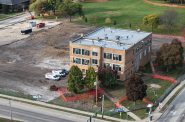 Oct 31st, 2025 by Jeramey Jannene
Oct 31st, 2025 by Jeramey Jannene
-
LaMarr Franklin Lofts Open, With A Waiting List
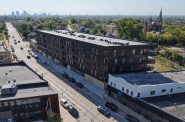 Oct 3rd, 2025 by Jeramey Jannene
Oct 3rd, 2025 by Jeramey Jannene
-
Airport Train Station Expansion Slowly Nears Completion
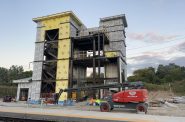 Sep 5th, 2025 by Jeramey Jannene
Sep 5th, 2025 by Jeramey Jannene


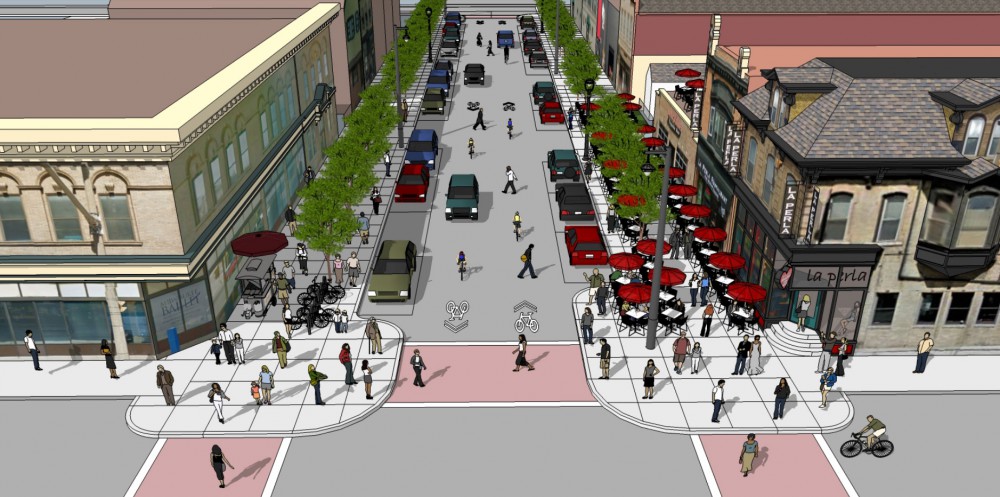
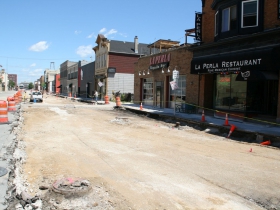
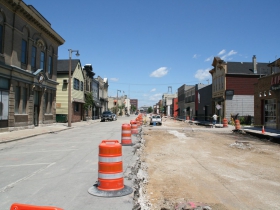
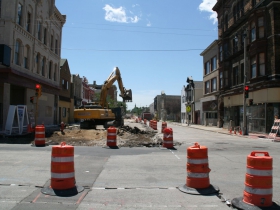
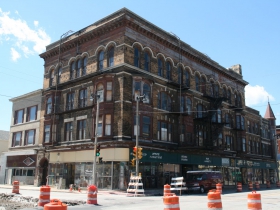
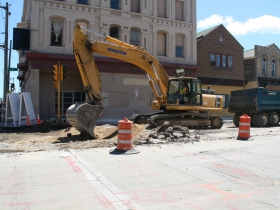
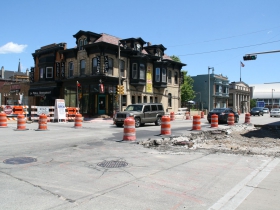



















What does the city have against bump outs?
This is why people move back into the city. When you rebuild a neighborhood around walkability and socialization opportunities, you get a community.
@max – I agree that it’s very disappointing that the city does not make corner bump outs standard practice when streets are reconstructed.
“According to co-owner JoAnne Anton, the decision came from a combination of factors, including that 5th Street is undergoing a major street construction project that is scheduled to last at least four months and will remove 75 percent of street parking to accommodate wider sidewalks.”, On Milwaukee.com.
Businesses and pedestrians on the same page.
Instead of fencing with the well-settled streetcar plans which will use no property tax revenue, Bay View could do itself a future by making KK Avenue a walkable (prosperous) place to spend time and money, to shop in our neighborhood. We need to learn from success S. 2nd Street and now S. 5th Street. Note that area businesses chose this design for practical reasons. Walking is where it is all going.
18 ft. sidewalks will not chase people (or cars) away. People (and their transport of choice) will follow an exciting neighborhood. Lulus and Riviera Maya get only five or six tables out of their sidewalk; I often walk by once the tables are filled. Think of the possibilities if the sidewalks were wider, traffic slower, and people happier to be in that environment.
I am relieved the bump outs were dropped.
They are bad for cars and bicyclists and potentially dangerous for pedestrains
when a car or truck bumps into a bump out. It makes no sense to put this
irregularity in the street.
A bump-out is safer for pedestrians for three reasons:
• It reduces the traffic distance pedestrians must cross
• It may cause drivers to slow down (especially when turning)
• It makes pedestrians more visible to turning vehicles
The only drawbacks are snow-plowing difficulty and 1-time construction costs. Since they don’t extend into traffic lanes, bump-outs shouldn’t be a problem for sober drivers and bikers.
Bump-outs will be installed at many streetcar stops.
I’m not sure had bump outs are bad for cyclists? As a daily commuter that rides down S 2nd through the 2nd & Greenfield intersection (bump outs on the North side of Greenfield) – I see no added danger from my perspective.
@Bill Sell
This works for 5th street because it’s a street that not only accommodates two lanes of traffic but also angled parking. Switching the parking to parallel provides the space for larger sidewalls. KK already has parallel parking and only two lanes of traffic. Widening the sidewalk would mean completely eliminating parking on KK and also placing the driving lane immediately adjacent to the sidewalk. That isn’t going to happen.
I know why people think they are safer. But it turns out there is no evidence to back it up.
More tellingly, many bump-outs now have signs alerting drivers to their presence. What does that tell you?
Might be safer to be standing on the sidewalk rather than a bump-out in the street.
Curb bump outs narrow the street at intersections which shortens the distance pedestrians have to walk in the street. They extend sidewalks. They make it much less likely that vehicles will be illegally parked in a manner than blocks crosswalks. They offer additional space for planters to be placed out of the way of typical pedestrian flows. And they offer space for pedestrians to wait to cross one street without blocking the path of pedestrians crossing the other street.
The fact that they are sometimes hit only demonstrates that too many motorists are turning corners too quickly. But I fail to see how they are problematic for bicyclists, as 5th St. does not and will not have bike lanes, and even if it did they do not extend into bike lanes.
While I found no studies showing a reduction in crashes due to bump outs, I did find one that showed a significant increase in drivers yielding to pedestrians at bump outs (compared to the same intersection without bump outs). Of course, increasing the rate at which drivers obey the law by yielding increases pedestrian safety and reduces the time needed for pedestrians to cross the street.
http://www.oregon.gov/ODOT/TD/TP_RES/docs/Reports/PedestrainSafetyCurbExt.pdf?ga=t
Signs alerting drivers might be needed when bump outs are new. Almost any significant traffic change (like a new stop sign or new signals) might merit warning signage for a few years (e.g. “Stop Ahead”). Another reason for signage might be for snow plow operators.
Here’s another safety improvement provided by bump outs…
Drivers often look left while turning right—searching for a gap in traffic—and all too often begin turning (entering the crosswalk) while still looking the “wrong way”. Bump outs add a few feet between the turn and crosswalk thereby increasing the odds the driver is actually looking forward before hitting the crosswalk.
I’m a bike ped planner. Curb extensions DO increase safety for pedestrians. It’s hard to get crash data that is valid because the frequency of pedestrian crashes is pretty low. But it’s easy to find data on the impact that curb extensions have on risk factors for crashes, especially vehicle speeds and yeilding behaviors.
Impact of curb extensions on crash risk factors:
–They reduce crossing distance, therefore they reduce the time that pedestrians are exposed to vehicle traffic.
–They reduce speeds of turning and through-movements
–They improve visibility of pedestrians waiting to cross
They also improve the geometry of the intersection for all road users because they make it possible for wheelchair ramps (and therefore crosswalks) to be closer to the actual intersection. Therefore cars waiting at an intersection to make a turn can wait 5-15 feet closer to the actual cross street, which improves visibility for drivers as well.
References:
FHWA: http://www.pedbikesafe.org/PEDSAFE/countermeasures_detail.cfm?CM_NUM=5
NACTO: http://nacto.org/publication/urban-street-design-guide/street-design-elements/curb-extensions/